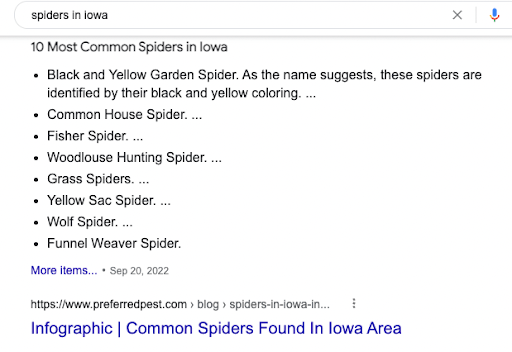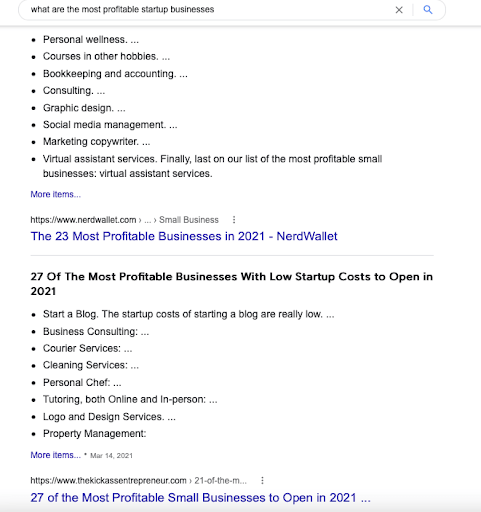January 9, 2023
Hannah Burke
SEOContent MarketingDigital Marketing
Understanding The Types Of Featured Snippets On Google
Google processes over 99,000 searches every single second, which makes more than 8.5 billion searches a day. Google Search results include many listings which appear when a web user submits a search query. One of the more prominent additions to Google’s search listings is featured snippets, which take up valuable real estate at the top of the results page in “position zero.” While many SEO professionals debate whether or not position zero is harmful for your website, Blue Compass firmly believes web pages benefit from taking up more space in search engine results pages (SERPs) and being the first organic result seen by the user.
Google’s mission is to deliver the most relevant, helpful results to a user based on the search query. Focusing on featured snippet optimizations and obtaining a featured snippet shows users searching for information about your industry that your web page is a credible source they can trust.
Blue Compass is an SEO-first company, and our digital marketing experts are always looking for ways to implement featured snippet optimizations and take up more Google real estate within SERPs. See what they have to say about the different types of featured snippets and how to rank for them.
What Is A Google Snippet?
Featured snippets are a quick and concise answer that provide helpful information to a user’s query and appear at the top of Google search results. The content shown in featured snippets is pulled directly from various web pages in Google’s index. Featured snippets can appear in many ways such as bulleted or numbered lists, tables or short paragraphs.
Because of their visual nature, featured snippets tend to attract more clicks and can lead to increased conversions. Appearing at the top of SERPs can increase brand authority and visibility since Google selects featured snippets they deem most relevant to a searcher’s query.
Examples Of Featured Snippets
SEO featured snippets have been slowly rolled out over recent years and are constantly changing and evolving their look. Check out examples of featured snippets below. Our team highlights the benefits of each with screenshots to help.
A Paragraph Featured Snippet
Paragraph featured snippets, also known as Google’s Answer Box, are often recognized as the most popular type of featured snippets. In paragraph featured snippets, Google extracts an excerpt of text from a web page to answer the searcher’s query. You can significantly boost your chance of taking over a paragraph featured snippet by answering the question you want to rank for immediately within a paragraph, and then follow it up with more in-depth information on the topic as needed later in the copy.
At Blue Compass, our best practice is to write your answer in a clear, concise 45-55 words. Doing so will ensure your full answer fits within the average size of an SEO featured snippet on SERPs.

The Numbered & Bulleted List Featured Snippets
Numbered list featured snippets contain content in the form of a numbered or otherwise sequential list and often lay out steps explaining how to do something, as is the case with recipes. These usually show for queries with DIY intent or asking “how to” or “how do I” do something.
Bulleted list featured snippets, on the other hand, are not sequential. These are great for showing the various types of something a user is searching for. As an example, a user searching for what kinds of spiders live in Iowa would likely receive a bulleted list snippet with each spider listed.
You can rank for list featured snippets by creating content using HTML ordered or unordered lists. In HTML, unordered lists use the
"ul" tag, whereas ordered lists use the "ol" tag. Both types of lists use the "li" tag for individual list items.

The Table Featured Snippet
This type of snippet helps users visualize data for different kinds of comparisons. The information the user is seeking is formatted in an easy-to-digest table format. Rather than conveying data in complete sentences, you can use hypertext markup language (HTML), a standard markup language for creating web pages that describes the structure of the page, to create a table so long as the data has two or more variables, and help your website rank for a table featured snippet.

The Video Featured Snippet
Video featured snippets contain content in the form of a video. Most of them involve YouTube videos since YouTube and Google are owned by the same parent company. Plus, YouTube videos are already prepared to be served as search results since YouTube is the second largest search engine in the world, according to Global Reach. When a user clicks a video featured snippet, it will load the YouTube page while automatically playing the depicted video.
Of course, you need to create video content and optimize it for search results on YouTube in order to rank for video featured snippets. Don't just host the video content directly on your website. Instead, upload it to YouTube to increase the chance of it ranking in a video featured snippet. You can embed the video content on your website from YouTube if you want to share it from your channel.
The video shows in SERPs with the video thumbnail and YouTube link, and often video chapters (or timestamps) if those are provided. In many cases, a video featured snippet will show an excerpt directly from the YouTube video description below the video. For best results, be sure to place the text you want Google to consider for your snippet at the beginning of your video's description.

The Double & 2-For-1 Featured Snippets
Double featured snippets include two sets of answer boxes, each including a unique answer. The answers come from two websites, usually in bullet points, and include the page titles and URLs of both sites.
A 2-for-1 featured snippet is extremely similar to a double featured snippet, except both answers are quoted from the same website. Google will likely show double or 2-for-1 featured snippets for results for which the user intent is unambiguous. Otherwise, these featured snippets would crowd out the alternative user intents.

How To Rank For Featured Snippets
As with traditional search rankings, there is no way to guarantee your website ranks for a featured snippet. Google has algorithms that consistently evaluate page content, SEO value, snippet opportunities, search rankings’ performance and more to see which provides the best responses to certain user queries.
However, you can create high-quality, targeted content with a high chance of being chosen. Our experts follow a few key featured snippet optimization practices you can use to increase your chances of landing a featured snippet:
- Identify a featured snippet opportunity that makes sense for your business and aim for it. Make sure you follow the same format of the current featured snippet. Reason being, that is the format Google has determined users prefer for this type of query, so they will most likely continue showing this type of result. For example, if a bulleted list featured snippet shows up, you will want to structure your content and schema as a bulleted list, as well.
- Format your content to follow SEO best practices with a H1 or H2 heading that states or addresses the question being asked.
- Write your answer in a clear and concise 45 to 55 words. This will ensure it fits within the average size of a featured snippet listing and the user can easily digest it.
- Back your answer up with more in-depth, quality content or statistics. This will give your page greater authority and SEO value to increase your chances of landing the featured snippet.
- Include schema markup on your page to ensure your content has a better chance of ranking for a featured snippet.
- Monitor search results for the page you’re optimizing for a featured snippet listing. If you see things start to shift in SERPs and you’re making progress, you may continue to see more positive changes and opportunities.
The examples of featured snippets above, however, aren't the only prominent type of search results websites should be trying to rank for, there are several rich result opportunities as well. Learn the differences between rich results vs. featured snippets below.
Rich Results vs. Featured Snippets
In short, a rich result is anything that is not a standard search result in Google. A wide variety of rich results can appear in search to enhance the traditional organic results and provide key information in easy-to-read ways. Structured data, a piece of code called schema, is implemented to a content piece to make it eligible to show up for rich results. Structured data provides a page's blueprint in a way that's easy for Google to understand.
Why Are Featured Snippets Important For Search Engine Optimization (SEO)?
Showing up for a featured snippet tends to increase traffic due to its position zero on the results page. When your content is featured in a visual element that stands out from a crowded list of standard results, you are more likely to attract attention and earn click-throughs to your pages.
Some SEO professionals argue that showing up for an SEO featured snippet can reduce click-through-rate (CTR) to that page because users are able to get the information they need directly on the results page. However, our team believes this isn’t much of a concern because we’ve seen our clients gain more qualified users clicking through to the page when they’ve won a featured snippet. Plus, it’s still more beneficial to show up for an SEO featured snippet versus one of your competitors having this prominent position.
We Can Optimize Your Content To Increase Your Featured Snippets Opportunities
Want to learn more about Google’s featured snippets and featured snippet optimizations? Our team of SEO experts and web developers are happy to assist you. Contact us today!